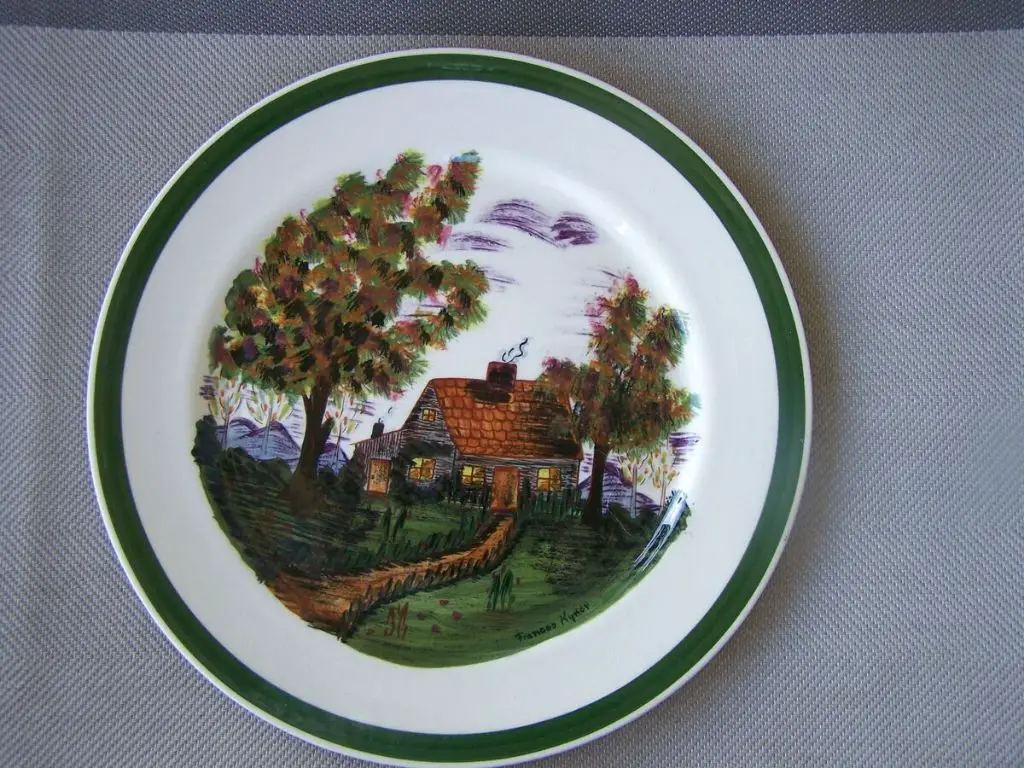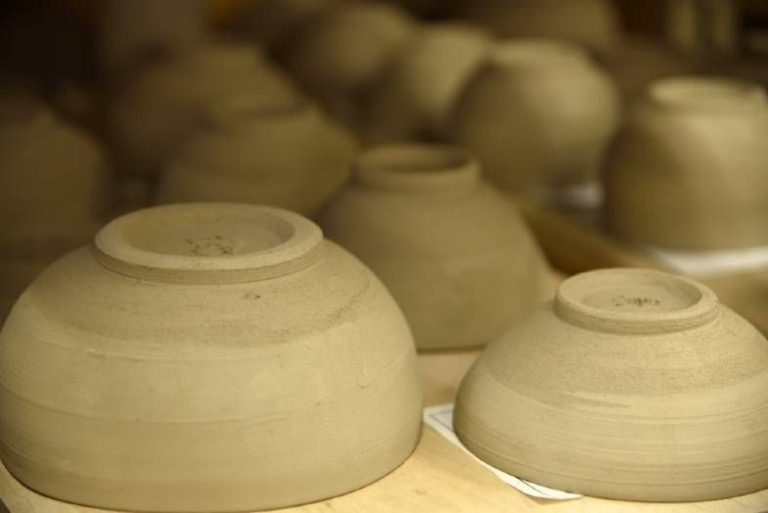Can Blue Ridge Pottery Go In Dishwasher?
Blue Ridge pottery refers to a specific type of stoneware pottery that originated in Appalachia in the early 20th century. The pottery is known for its distinctive hand-painted designs featuring nature scenes, flowers, and geometric patterns in blue, yellow, green, pink, and brown glazes. Blue Ridge Southern Potteries, founded in 1938 in Erwin, Tennessee, was one of the most well-known producers of Blue Ridge pottery dinnerware sets.
This article provides an overview of whether Blue Ridge pottery can safely be cleaned in the dishwasher. It examines the composition and properties of Blue Ridge pottery, the effects of dishwasher detergents and processes, recommendations from manufacturers, and experiences of Blue Ridge pottery owners. The goal is to inform readers whether dishwasher use is advisable for Blue Ridge pottery or if handwashing is a safer alternative in order to avoid damaging these collectible vintage dishes.
Composition of Blue Ridge Pottery
Blue Ridge Pottery is made from red clay sourced from local areas near the factory in the Blue Ridge Mountains. The clay body contains kaolin, or china clay, as well as quartz, feldspar, and iron oxides which give the pottery its reddish-brown natural color before glazing (https://www.pinterest.com/pin/pie-plate-blue-ridge-china-julie-pattern-etsy–411797959692874451/).
The pottery pieces are decorated with vibrant colored lead-free glazes made from silica, fluxes like soda and borax, zinc oxide, and various colorants and opacifiers. Popular glaze colors include pink, yellow, blue, green, and white. The glazes are hand-painted by decorators before firing using traditional brushwork techniques to create the colorful floral, fruit, and geometric designs (https://www.ebay.com/itm/314913065154).
After glazing, the pottery undergoes a single firing at over 2200°F to mature the clay and fuse the glazes to the clay body. Blue Ridge Pottery is considered earthenware due to its porous clay composition and low-temperature firing.
Dishwasher Detergents and Process
Modern dishwashers rely on a combination of hot water and chemical detergents to effectively clean dishes. Most home dishwashers reach internal temperatures between 130-140°F during their main wash cycle [1]. Commercial dishwashers designed for restaurants and other food service operations are generally set to maintain temperatures between 160-180°F [2] in order to meet food safety standards.
Along with heat, dishwasher detergents contain powerful cleaning agents like enzymes, surfactants, and alkaline builders that break down and remove food residues. Common active ingredients include sodium carbonate, sodium silicate, chlorine-based bleach, and non-chlorine oxidizing agents [3]. These chemicals loosen dirt, dissolve grease, prevent spots, and sanitize dishes and utensils.
Effects of Dishwasher on Pottery
Dishwashers can impact pottery in a few key ways. The main factors are the heat cycles and detergents used in dishwashing.
The high heat from dishwashers can cause problems for some types of pottery glazes. Glazes with a lower melting point may become cloudy or develop cracks called crazing when exposed to heat cycles over 130°F (1). The high temperatures can also cause colors to fade or change on some glazed pottery over time (2).
Dishwasher detergents, especially those with bleach, acids, or abrasives, can also degrade pottery glazes. The chemicals may etch into the glaze surface causing loss of shine and exposing porous clay (1, 3). Any cracks or flaws in the glaze provide access for detergents to penetrate and damage the clay body. Stronger alkaline dishwasher detergents have the most potential for glaze damage.
In summary, the combination of heat, pressure, and harsh detergents in a dishwasher can potentially degrade glazes and alter the appearance of pottery over repeat washings. Glazes with pre-existing cracks or flaws are most susceptible to damage.
(1) https://community.ceramicartsdaily.org/topic/22967-glaze-fadecolor-change-after-running-in-dishwasher/
(2) https://www.finishdishwashing.com/ultimate-dishwashing-guide/loading/ceramics/
(3) https://www.reddit.com/r/Pottery/comments/t4l9e1/can_i_put_my_handmade_pottery_in_the_dishwasher/
Manufacturer Recommendations
Blue Ridge Pottery was originally produced in the mountains of North Carolina starting in the early 20th century. According to the vintage collectibles website HobbyLark, “Blue Ridge Pottery dishes made in the Appalachian mountains are very popular with collectors” (https://hobbylark.com/collecting/Blue-Ridge-Dishes). As an antique collectible, guidelines from the original Blue Ridge manufacturers can help collectors properly care for these dishes.
Most Blue Ridge Pottery pieces would have included care instructions recommending “Hand Wash Only” at the time they were produced, as evidenced by this 1940s snack plate listing on eBay (https://www.ebay.com/itm/175973760214). The porous nature of the clay and handmade artisanal style of the pottery causes it to be more susceptible to damage from harsh dishwasher detergents and the high heat drying cycle. As a result, collectors looking to preserve the value of their Blue Ridge dishes should follow the manufacturer’s guidance and wash them by hand.
Experiences of Owners
Many owners of Blue Ridge pottery dishes have shared their experiences with washing the pottery in the dishwasher. According to discussions on collectors’ forums, most owners do not recommend putting Blue Ridge dishes in the dishwasher as it can lead to fading of designs and glaze issues over time.
For example, one collector shared on a Blue Ridge Pottery Facebook group that they had noticed fading and wear on pieces washed repeatedly in the dishwasher: “I’ve had a few pieces lose color definition after many trips through the dishwasher.” Source
Other owners have noticed the glaze becoming “cloudy” and losing its shine when subjected to high dishwasher heat and harsh detergents over time. As one owner commented on a forum: “I stopped putting my Blue Ridge in the dishwasher because the glaze started looking frosted and cloudy rather than shiny.” Source
Based on these anecdotal experiences, most collectors recommend handwashing Blue Ridge pottery to preserve the appearance, color vibrancy, and glaze finish of the pieces over many years of use. Gentler handwashing allows owners to enjoy their Blue Ridge pottery while maintaining its aesthetic qualities.
Best Practices
When caring for handmade Blue Ridge pottery, most experts recommend handwashing over using the dishwasher. Handwashing allows you to gently clean the pottery with a soft sponge or cloth to prevent scratching or damaging the glaze or clay body. According to Mammoth & Minnow, “Hand washing will be the gentlest on the pottery and less likely to degrade the glaze over time.”

If you do opt to wash your Blue Ridge pottery in the dishwasher, use caution and follow the recommended settings. GG Clayworks suggests using “a gentle wash cycle with room temperature water.” You’ll also want to make sure to use a mild detergent, as harsh soaps can be too abrasive. Allow your pottery to completely air dry rather than using the high heat of the dishwasher drying cycle.
Overall, handwashing is ideal for preventing wear and maximizing the longevity of your Blue Ridge pottery. But occasional gentle dishwasher cycles are generally considered safe if needed. Just be sure to avoid extreme water temperatures or harsh soaps that could damage the finish.
Potential Damage
Dishwashers can potentially cause several types of damage to Blue Ridge Pottery and other handmade ceramics:
- Cracking: The high heat, pressure, and force of water jets in a dishwasher can cause hairline cracks or chips in pottery. Glazes have different rates of expansion, which can lead to cracks from thermal stress. In addition, items bumping together can chip edges.1
- Fading: Many glazes and hand-painted designs can fade, run, or become dulled after repeated dishwasher cycles. The heat and detergents degrade pigments over time.2
- Loss of sheen: Polished finishes and glossy glazes will eventually lose their luster and become matte. This is particularly true for metallic lusters, as the detergents corrode the fine metallic particles in the glaze.3
To avoid damage, it’s best to hand wash prized Blue Ridge Pottery pieces. However, some stoneware items may be durable enough to occasionally withstand the dishwasher.
Alternatives to Dishwashing
Instead of using an automated dishwasher, there are alternative cleaning methods for Blue Ridge pottery that may be gentler and help preserve the finish.
Handwashing is one recommended approach. Use a soft sponge or cloth with warm water and a mild detergent. Avoid abrasive scouring pads or brushes that could scratch the pottery. Gently clean the surface using circular motions. Rinse thoroughly afterwards and dry completely with a soft towel.
For tougher stains or buildup, fill a container with warm water and add a small amount of bleach or ammonia, then allow the pottery to soak. Check regularly and use a soft cloth to gently remove any softened material. Rinse and dry thoroughly when clean.
Baking soda can also be effective for cleaning pottery. Make a paste with water and apply to stained areas. Let sit for 5-10 minutes before scrubbing off. Vinegar is another natural cleaning solution that helps remove hard water deposits and other stains.
With careful handwashing and the use of gentle cleaners, Blue Ridge pottery can be kept looking beautiful while avoiding any damage from harsh dishwasher detergents or high heat drying cycles.
Conclusion
In summary, whether Blue Ridge pottery can safely go in the dishwasher depends primarily on a few key factors – the type of clay used, the glaze, quality and age of the piece, and the dishwasher settings and detergent used. While some modern Blue Ridge pieces may be dishwasher safe if used gently, many antique and collectible pieces are too delicate and porous for the high heat and harsh detergents. Handwashing is always the safest option.
For collectors looking to preserve Blue Ridge pottery and prevent discoloration, cracking, crazing, or leaching of chemicals from the glaze, handwashing with a gentle detergent is strongly recommended. However, for everyday use, cautiously trying the dishwasher on newer less porous clay bodies and lead-free glazes is reasonable if done carefully – use low heat, no heated dry cycle, mild detergent, place piece carefully without touching other dishes, and check for any issues afterwards. Examine manufacturer information when possible.
With proper care, beautiful handmade Blue Ridge pottery can last for many generations. While the convenience of the dishwasher is tempting, take some extra time to wash this regional artisan craft carefully by hand and you’ll be rewarded with many years of use.




